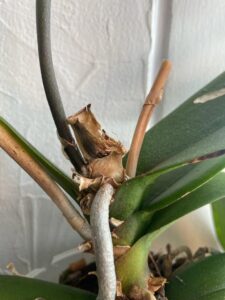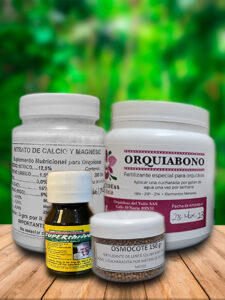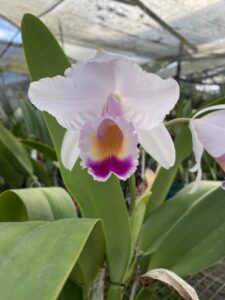Have you ever received a beautiful gift or added a splash of color to your home with a lovely spike full of flowers? Yet, after a few months, these stunning blooms have withered away and fallen, leaving your plant forgotten in a corner. Did you know that there’s a way to make it bloom again and bring vibrant colors back into your home?
There’s no exact formula to make your orchid bloom quickly again. Instead, achieving this goal involves creating the perfect environment where it feels comfortable enough to produce a new flower spike. This requires understanding your orchid’s natural habitat and recreating it as closely as possible.
First and foremost, you need to know the characteristics of the specific type of orchid you have, as each type has its own unique needs. Then, ensure your home provides suitable lighting, temperature, and proper watering and fertilization.
In this case, we’ll focus on the needs of Phalaenopsis orchids, as they are commonly found in our homes.
1. Check Plant Health:
Remember that producing and maintaining flowers requires a significant amount of energy and nutrients. A healthy orchid is more likely to grow and bloom successfully. To ensure your orchid’s well-being, assess these three aspects:
– Leaves: Healthy Phalaenopsis orchids have strong, vibrant leaves that indicate appropriate hydration.
– Roots: Healthy roots are green, thick, and robust. Dry and thin roots are a sign of dehydration.
– Flower Spike: In their native state, Phalaenopsis orchids have flower spikes pointing in various directions. When potted, it’s recommended to tie the flower spike to a support to keep it upright. Do this before the buds open, as they lose orientation at that point. Additionally, trim the flower spike 2 cm above the second node (thickening parts of the stem) after all the flowers have fallen, as a new flower spike can emerge from this node.
2. Lighting:
Most orchids, including Phalaenopsis, evolved under tree branches and prefer indirect light. Placing them near a window, on a balcony with indirect light, or in a shaded greenhouse with around 70% shade is ideal. Avoid direct sunlight, as it can cause burns.
3. Watering:
Avoid overwatering your orchid, as this can lead to bacterial growth and root rot. Ensure that your substrate, pot, or mounting material provides good drainage and keeps the orchid slightly moist without becoming waterlogged. A common orchid substrate is a mix of Pátula pine bark and charcoal, which provides proper drainage and moisture balance. Water your orchid twice a week, and during hot days, water more frequently if they’re in bloom. Morning watering is advisable to allow the plant to dry before nightfall, as wet conditions during cooler temperatures can lead to bacterial issues and leaf damage.
4. Temperature:
Phalaenopsis orchids prefer warm climates (20°C to 30°C or 68°F to 86°F) but can tolerate cooler conditions as well. It’s important to protect them from extreme weather conditions and provide changes in temperature, especially at night, to encourage flowering.
5. Humidity:
Many orchids are native to humid tropical climates. Aim for an ambient humidity level between 50% and 80%. You can use humidifiers or humidity trays to achieve the ideal environment. If you live in Cali or any Colombian city, you may not need to worry about humidity, as the tropical climate naturally provides suitable conditions for Phalaenopsis orchids.
6. Fertilization:
Phalaenopsis orchids are epiphytes, living on trees that provide support and nutrients. When potted, they won’t receive the necessary nutrients from only tap water. Therefore, they require additional fertilization to thrive. A balanced fertilizer like “Orquíabono” designed specifically for orchids, is recommended. Apply it once a week, mixing 1 tablespoon per gallon of water. Follow the recommended doses, as over-fertilizing can harm the plant.
As a preventative measure and to enhance fertilizer effectiveness, you can add a teaspoon of PHYSAN or a drop of SUPERTHRIVE to your fertilizer mixture during application. PHYSAN is a disinfectant detergent that helps prevent diseases and control algae and moss growth. SUPERTHRIVE contains hormones and vitamins that encourage root and bud growth.
Remember that it’s crucial to repot your orchid after each flowering cycle and use a suitable medium like “Orquimedio” (medium or coarse grade) – available at our stores in Ginebra and Cali or on our website. Never plant orchids in regular soil, as it won’t provide proper drainage or moisture retention.
*This process requires patience, care, and consistency to create an environment in which your orchid can thrive and reward you with beautiful blooms in about 8 months.
“Orchids aren’t complicated; they’re just a tad different.”
You can purchase the substrate on our website or in our stores in Cali and Ginebra. If you have any questions, you can visit our stores, where our staff can provide more suggestions. Additionally, we have all the necessary accessories for your orchid cultivation, from Orquimedio (substrate) to Orquitutor, decorative bases, Orquiabono, planters, and many other things.





